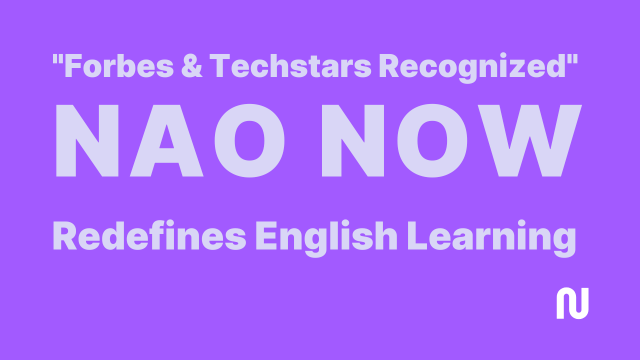Why Kids Hate English Classes—And the Smarter Way to Teach Speaking






.png)
How Should You Start Your Child’s English Learning Journey?
If you're unsure where and how to begin teaching your child English, you're not alone.
Let’s start with one key fact:
Elementary school is the ideal time to learn a new language.
At this age, children absorb language naturally—just like they learned their native language.
But using the wrong methods can lead to frustration, boredom, and negative feelings toward English.
So how do we help kids enjoy learning and build real communication skills?
Nao Now is built around that exact question.
We designed a curriculum that helps children think, speak, and express themselves in English—not just study it.
Why Kids Often Dislike English Academies
Many parents expect their child’s English to improve naturally by enrolling them in a cram school or private academy. But in reality, kids often lose interest or even begin to dislike English altogether. Why?
Here are the top three reasons:
- Rigid, repetitive teaching methods
Grammar drills, memorized vocabulary tests, and fixed-answer lessons become mentally exhausting and boring for kids. - Little to no opportunity to express themselves
Most lessons focus on listening and memorization. Children end up “understanding but not speaking.” - Unrelatable or dull content
Textbook examples often feel disconnected from everyday life. Kids lose focus when they don’t see how English relates to them.
Here’s the truth: It’s not that kids dislike English. They dislike how it’s taught.
Imagine a class where your child asks questions, gives opinions, and actively participates—all while learning English. That’s what we offer.
Why You Should Start in Elementary School
Research shows that ages 6–12 are the “golden years” for language development.
At this age, children can absorb sounds and sentence patterns like native speakers.
Early exposure to real English boosts speaking confidence and listening skills much faster than in later years.
That’s why it’s critical to begin now—with the right method.
The Wrong Way to Learn: Memorization-Only
Many parents begin with rote memorization—lists of vocabulary or grammar rules.
But this can quickly kill a child’s curiosity.
Instead, children should learn naturally, through play, movement, and real communication.
The key is interest-based learning. When kids are engaged and having fun, they stay motivated and improve much faster.
The 3 Core Principles of Effective Elementary English
1. Learn by Speaking (Communicative Approach)
Nao Now focuses on real conversations from day one.
Instead of explaining grammar rules, mentors help children speak through real questions and answers.
For example, a mentor might ask, “What’s your favorite food?”
The child forms their own sentence, speaks it aloud, and naturally learns new vocabulary and sentence patterns.
2. Learn with All Five Senses (Multisensory Learning)
Nao Now uses sight, sound, movement, and interaction.
Kids sing, dance, draw, act—and speak English while doing it.
By engaging multiple senses at once, memory retention and focus improve dramatically.
It also makes learning fun, not stressful.
3. Personalized Feedback at the Right Level (Scaffolded Learning)
Every lesson is tailored to the child’s ability.
Mentors adjust questions and guidance based on each student's pace and understanding.
This technique—called scaffolding—helps kids feel challenged but not overwhelmed.
It builds confidence and encourages progress.
5 English Learning Activities Kids Actually Love
1. Phonics + Interactive Games
We combine sound training with fun games.
Children learn tricky sounds like /f/ vs. /p/, /r/ vs. /l/, through chants and phonics games with characters.
This is especially useful for Korean learners who struggle with unfamiliar sounds.
2. Vocabulary Through Video and Sound
Instead of just memorizing words, kids see and hear the words in action.
For example, when learning “burger,” they watch a sizzling burger being grilled—creating a strong memory link.
Games then reinforce what they saw and heard.
3. Speaking & Listening Practice: Chants + Feedback
At Nao Now, everything is built around live conversation.
Mentors ask questions, kids answer in full sentences.
Children receive real-time praise and corrections, helping them build speaking confidence with each class.
They even re-listen to their own sentences to self-correct.
4. Interactive Reading: Thinking Through Questions
We don’t just “read books.”
Mentors ask follow-up questions like, “Why do you think the character felt sad?”
This improves critical thinking and English expression.
Children also draw or discuss the book afterward, building emotional connection to the story.
5. Presentations & Roleplay
Kids present ideas or act out scenes based on the lesson topic.
For example, if the topic is “zoo,” they pretend to be animals and explain them in English.
This builds creativity, speaking fluency, and real presentation skills—without pressure.
Why Nao Now Works (When Others Don’t)
🎓 Expert Mentorship Makes the Difference
Nao Now mentors aren’t just native speakers.
They’re Ivy League graduates from top U.S. universities, with backgrounds in education, science, arts, and more.
Mentors tailor each lesson to the child’s goals and personality—and often become inspiring role models.
🧠 Personalized Lessons + Real-Time Feedback
Every lesson is 1-on-1 and fully customized.
Parents receive video recordings and feedback reports after each session, making it easy to track growth and improvement areas.
📚 Research-Based Curriculum
Our curriculum is built on research from Harvard, Stanford, Oxford, and Cambridge.
We combine:
- Multisensory methods
- Culture-based topics
- Scaffolded learning
To teach not just grammar, but real-world communication in English.



.png)





.png)
.png)
.png)

.png)